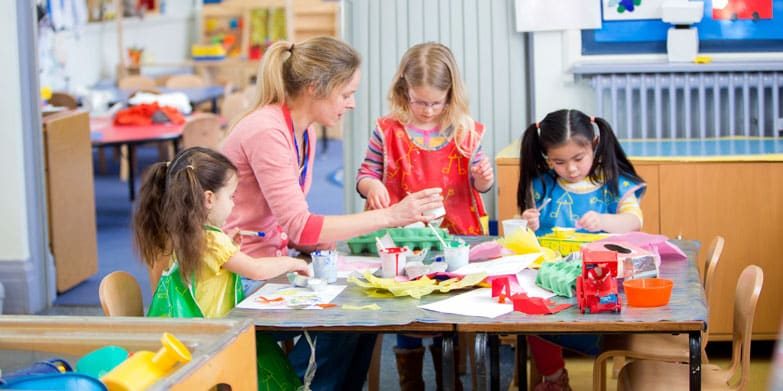Are you trying to determine the main differences between a preschool and a long daycare centre? There are many choices to make for your little ones in the first years of their life. Some are as simple as what to give them for breakfast, but others are not. Choosing between preschool and a long daycare can be one of those more complicated decisions. To make it easier, here are the key differences to help you work out what’s best for your family.
For some families, choosing between preschool and a long daycare centre may come down to the parents’ working hours, meaning a long daycare, childcare centre, or early learning centre is the only option.
For others, choosing between preschool and long daycare can be agonising. After all, you’re taking the first step on your child’s educational journey. Or maybe it’s the first time you let your little one out into the big wide world. Ultimately, your decision will come down to what is best for you, your family, and your child.
NORTH SHORE CHILDCARE & EARLY LEARNING CENTRE GUIDE
What are the differences between a Preschool and Long Daycare Centre?
Age of child
- Long daycare centres typically cater to children aged 6 weeks to 5 years old.
- Preschools specifically cater for 3 to 5-year-olds.

Babies from 6 weeks old can be cared for at Daycares
Hours
- Long daycare centres usually run from 7/7.30am until 6-7pm, and the centres are open for 48-50 weeks of the year. Often, parents can choose the days they would like their child to attend, subject to availability.
- Preschools operate in line with school terms, typically 42 weeks of the year, with hours 8:30am – 3:30pm (with some variations between centres). Often, children will have dedicated days to attend (e.g. Mon-Wed or Thurs-Fri).
Costs
The cost of childcare, whether preschool or long daycare, can be complex. The Child Care Subsidy provides reduced fees by the Australian Government, but your Child Care Subsidy percentage and hours of subsidised care depend on:
- your family income
- the type of care you use
- the hours of activity you and your partner do.
In general, day rates at long daycare centres range from $100-$180 per day, and qualifying families are eligible for a number of rebates and benefits.
Affordable Preschool has been introduced as part of the Start Strong Program across preschools and long daycares. Families can save up to $4,220 a year for 3-5-year-old children in community and mobile preschools. At the same time, families will save up to $2,110 a year for 4-5-year-old children in eligible preschool programs in long day care, in addition to the Child Care Subsidy. You can only access fee relief from one eligible service at any given time. Read more here.

Only About Children is a long daycare centre with 20+ locations on the North Shore
Philosophies and Learning Outcomes
Previously, long daycare centres had a reputation for ‘caring’ for children, while preschool was associated with a focus on ‘early education’. Over the years, this has changed, with the development of the Early Years Learning Framework (practices that support and enhance learning from birth to five years of age).
Many preschools run a ‘Preschool Program’ from 9 a.m. to 3 p.m. every day to prepare children for their future schooling. Long daycare educators also schedule the ‘Preschool Program’ at particular times and days of the week to accommodate children attending various hours and days (due to the extended hours).
Staffing
Staffing can vary substantially from centre to centre, so it’s worth asking about this when you tour the preschool or daycare.
Due to the extended hours at long daycare centres, staff members may work a rotating roster and children may have different educators throughout the day, week, or fortnight. Educators may also rotate across the various age rooms, although this is not always true. As a positive, exposure to various teaching approaches and personalities may suit some children and provide variety.
Educators may be more consistent at preschools due to shorter hours and working permanent days and because preschools run concurrently with the school terms. In this case, the consistency of teaching and familiarity of faces may benefit some children.
Educator ratios must be maintained at all times for both preschools and daycares. These requirements apply to all locations where a service is operating, not just individual rooms or areas, and include times when children are being transported under the care of the service. The minimum number of educators required to educate and care for children at a centre-based service is to be calculated by the following ratios for children:
- from birth to 24 months of age—1 educator to 4 children;
- over 24 months and less than 36 months of age—1 educator to 5 children;
- aged 36 months of age or over (not including children over preschool age) —1 educator to 10 children (in NSW);
- over preschool age, 1 educator to 15 children.
Are there any differences in routines between preschool and daycare centres?
Many childcare centres provide all food, including a hot lunch. For most of the day, they are sectioned into smaller, age-appropriate areas and merged together at other times, providing a mix of social experiences.
Preschool routines generally imitate the school environment, including bringing morning tea and lunch from home and setting drop-off and pick-up times that coincide with the school day, which is helpful when you have older children attending school. Preschool facility resources and equipment are specifically dedicated to the developmental needs of 3-5-year-olds.

Castlecrag Montessori School
Whatever decision you make for your child, be sure to tour a range of different centres and find what feels right for your child and your family. Whether they attend preschool or long daycare, all we hope is that our children come home trailing glitter, stained in paint, and talking about the great things they have done that day!
NORTH SHORE CHILDCARE & EARLY LEARNING CENTRE GUIDE












